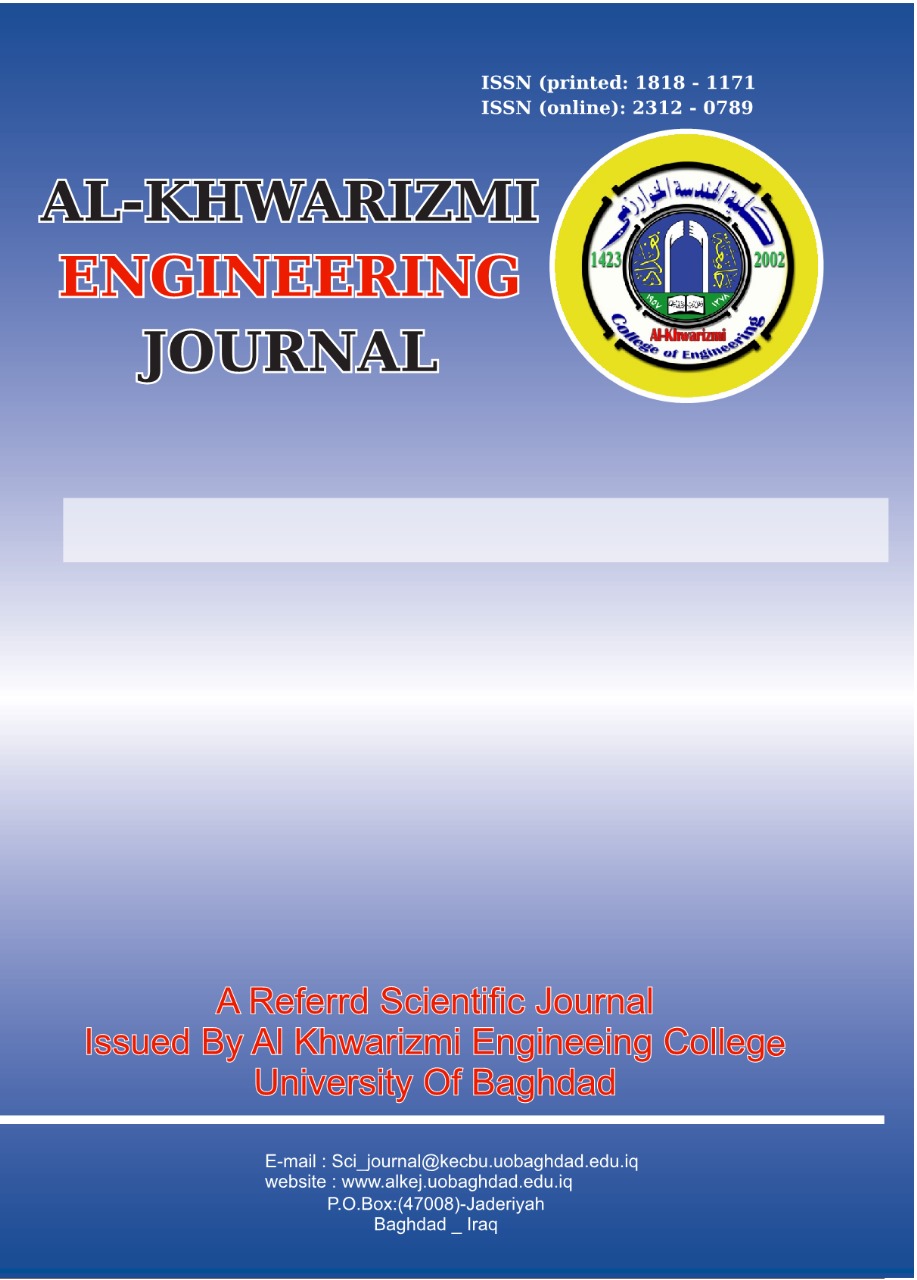Removal of Methylene Blue from Wastewater Using AL Haji Plant as a Low-Cost, Eco-Friendly Adsorbent
DOI:
https://doi.org/10.22153/kej.2025.02.002Keywords:
Al Haji plant; Batch sorption; Kinetic models; Methylene blue; Thermodynamic Parameter.Abstract
This study investigates the use of agricultural waste, specifically the Al Haji plant, for wastewater treatment. The term 'Al Haji plant' refers to species from the Al Haji genus, particularly "Al Haji maurorum " and "Al Haji canescens ", which are drought-resistant plants of the Fabaceae family. Traditionally, these plants are known for their medicinal and antimicrobial properties. In this research, waste from the Al Haji plant was converted into activated carbon (AC) as a low-cost and techno-economically viable biosorbent for the removal of methylene blue (MB) dye from wastewater. The production of AC involved two key steps: chemical activation using sodium hydroxide (NaOH) and carbonisation at 300 °C. The properties and adsorption potential of the resulting AC were investigated. Various parameters were studied, including pH, contact time, stirring rate, initial dye concentration, adsorbent dosage, and temperature. Characterisation of the biosorbents was performed using Scanning Electron Microscopy (SEM) and Brunauer–Emmett–Teller (BET) surface area analysis. The SEM investigation showed notable pores in the Al Haji plant sample that could enhance the absorption of the MB dye. Results indicated that the BET surface area for physical AC is 25.5796 m²/g. The surface area of chemical AC was reported as 16.2767 m²/g. The dye exhibited pseudofirst-order adsorption kinetics, with average rate constants of 0.020082 and 0.001589 for physical and chemical activation approaches, respectively. An adsorption isotherm study was performed using the Langmuir model, which showed an R² value of 0.827 and a maximum adsorption capacity of 5.24 mg/g." The study of adsorption thermodynamics revealed that MB adsorption on Al Haji activated carbon is spontaneous and endothermic.
Downloads
References
Zhang, T., et al., Removal of heavy metals and dyes by clay-based adsorbents: From natural clays to 1D and 2D nano-composites. Chemical Engineering Journal, 2021. 420: p. 127574.
Lellis, B., et al., Effects of textile dyes on health and the environment and bioremediation potential of living organisms. Biotechnology Research and Innovation, 2019. 3(2): p. 275-290.
Karim, A.B., et al., Élimination du colorant basique «Bleu de Méthylène» en solution aqueuse par l’argile de Safi. Revue des sciences de l'eau, 2010. 23(4): p. 375-388.
Obed, A.S. and W.M. Sheet, Removal of Azo Dye (Dispersed Red 17) Using Activated Carbon and Studying the Influencing and Kinetic Factors. Mathematical Statistician and Engineering Applications, 2023. 72(1): p. 2246–2256-2246–2256.
Hamad, H., et al., A novel modification and selective route for the adsorption of Pb2+ by oak charcoal functionalized with glutaraldehyde. Advanced Powder Technology, 2016. 27(2): p. 631-637.
Yurtsever, M. and İ.A. Şengil, Biosorption of Pb (II) ions by modified quebracho tannin resin. Journal of Hazardous Materials, 2009. 163(1): p. 58-64.
Hamidpour, M., et al., Sorption hysteresis of Cd (II) and Pb (II) on natural zeolite and bentonite. Journal of hazardous materials, 2010. 181(1-3): p. 686-691.
Yang, L., et al., Development of eco-friendly CO2-responsive cellulose nanofibril aerogels as “green” adsorbents for anionic dyes removal. Journal of Hazardous Materials, 2021. 405: p. 124194.
Saleh, T.A. and V.K. Gupta, Photo-catalyzed degradation of hazardous dye methyl orange by use of a composite catalyst consisting of multi-walled carbon nanotubes and titanium dioxide. Journal of colloid and interface science, 2012. 371(1): p. 101-106.
Gupta, V.K., et al., Removal of the hazardous dye—Tartrazine by photodegradation on titanium dioxide surface. Materials science and engineering: C, 2011. 31(5): p. 1062-1067.
Nassar, N.N., Rapid removal and recovery of Pb (II) from wastewater by magnetic nanoadsorbents. Journal of hazardous materials, 2010. 184(1-3): p. 538-546.
Shooto, N.D., P.M. Thabede, and E.B. Naidoo, Simultaneous adsorptive study of toxic metal ions in quaternary system from aqueous solution using low cost black cumin seeds (Nigella sativa) adsorbents. South African Journal of Chemical Engineering, 2019. 30: p. 15-27.
Khan, N.A., S. Ibrahim, and P. Subramaniam, Elimination of heavy metals from wastewater using agricultural wastes as adsorbents. Malaysian journal of science, 2004. 23(1): p. 43-51.
Peng, L., et al., Molecular characterization of H9N2 influenza virus isolated from mink and its pathogenesis in mink. Veterinary Microbiology, 2015. 176(1-2): p. 88-96.
Dimbo, D., et al., Methylene blue adsorption from aqueous solution using activated carbon of spathodea campanulata. Results in Engineering, 2024: p. 101910.
Salman, S.D., I.M. Rasheed, and A.K. Mohammed. Adsorption of heavy metal ions using activated carbon derived from Eichhornia (water hyacinth). in IOP Conference Series: Earth and Environmental Science. 2021. IOP Publishing.
Jagtoyen, M. and F. Derbyshire, Activated carbons from yellow poplar and white oak by H3PO4 activation. Carbon, 1998. 36(7-8): p. 1085-1097.
Ting, Y., F. Lawson, and I. Prince, Uptake of cadmium and zinc by the alga Chlorella vulgaris: Part 1. Individual ion species. Biotechnology and Bioengineering, 1989. 34(7): p. 990-999.
Albroomi, H., et al. Removal Of A Basic And Azo Dye From Aqueous Solution By Adsorption Using Activated Carbon. in The International Conference on Chemical and Environmental Engineering. 2014. Military Technical College.
Annadurai, G., R.-S. Juang, and D.-J. Lee, Use of cellulose-based wastes for adsorption of dyes from aqueous solutions. Journal of hazardous materials, 2002. 92(3): p. 263-274.
Nouri, L., et al., Batch sorption dynamics and equilibrium for the removal of cadmium ions from aqueous phase using wheat bran. Journal of hazardous materials, 2007. 149(1): p. 115-125.
Doğan, M. and M. Alkan, Adsorption kinetics of methyl violet onto perlite. Chemosphere, 2003. 50(4): p. 517-528.
Gupta, A., S. Mahajan, and R. Sharma, Evaluation of antimicrobial activity of Curcuma longa rhizome extract against Staphylococcus aureus. Biotechnology reports, 2015. 6: p. 51-55.
Utsev, J., R. Iwar, and K. Ifyalem, Adsorption of methylene blue from aqueous solution onto delonix regia pod activated carbon: batch equilibrium isotherm, kinetic and thermodynamic studies. Agric. waste, 2020. 4(5): p. 18.
Budinova, T., et al., Characterization and application of activated carbon produced by H3PO4 and water vapor activation. Fuel processing technology, 2006. 87(10): p. 899-905.
Hameed, H.F., A.K. Mohammed, and D.S. Zageer, Comparative study between activated carbon and charcoal for the development of latent fingerprints on nonporous surfaces. Al-Khwarizmi Engineering Journal, 2022. 18(4): p. 1-13.
Fito, J., M. Abewaa, and T. Nkambule, Magnetite-impregnated biochar of parthenium hysterophorus for adsorption of Cr (VI) from tannery industrial wastewater. Applied Water Science, 2023. 13(3): p. 78.
Li, S., et al., Preparation and characterization of super activated carbon produced from gulfweed by KOH activation. Microporous and Mesoporous Materials, 2017. 243: p. 291-300.
Sabah, I., Adsorption of Congo red dye from aqueous solutions by wheat husk. Journal of Engineering, 2019. 25(12): p. 72-84.
Rashid, I.M., et al., Green synthesis of nickle oxide nanoparticles for adsorption of dyes. Sains Malaysiana, 2022. 51(2): p. 533-546.
Cordova Estrada, A.K., F. Cordova Lozano, and R.A. Lara Díaz, Thermodynamics and kinetic studies for the adsorption process of methyl orange by magnetic activated carbons. Air, Soil and Water Research, 2021. 14: p. 11786221211013336.
Romero-Gonzalez, J., et al., Determination of thermodynamic parameters of Cr (VI) adsorption from aqueous solution onto Agave lechuguilla biomass. The Journal of chemical thermodynamics, 2005. 37(4): p. 343-347.
Oguz, E., Adsorption characteristics and the kinetics of the Cr (VI) on the Thuja oriantalis. Colloids and Surfaces A: Physicochemical and Engineering Aspects, 2005. 252(2-3): p. 121-128.
Downloads
Published
Issue
Section
License
Copyright (c) 2025 Al-Khwarizmi Engineering Journal

This work is licensed under a Creative Commons Attribution 4.0 International License.
Copyright: Open Access authors retain the copyrights of their papers, and all open access articles are distributed under the terms of the Creative Commons Attribution License, which permits unrestricted use, distribution, and reproduction in any medium, provided that the original work is properly cited. The use of general descriptive names, trade names, trademarks, and so forth in this publication, even if not specifically identified, does not imply that these names are not protected by the relevant laws and regulations. While the advice and information in this journal are believed to be true and accurate on the date of its going to press, neither the authors, the editors, nor the publisher can accept any legal responsibility for any errors or omissions that may be made. The publisher makes no warranty, express or implied, with respect to the material contained herein.















